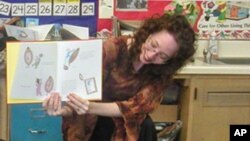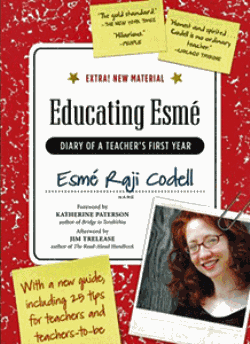When Esme Codell first entered her assigned classroom as a new teacher, she encountered 31, 10-year-olds and many unexpected challenges. To cope, she invented her own style of teaching, which she explained in her 1999 book, Educating Esme: Diary of a Teacher's First Year. It sold over 200,000 copies. A new, expanded edition includes more tips for young teachers.
Becoming a teacher wasn't Esme Codell's childhood dream. She didn't even consider it as a career until she saw how deeply the profession touches kids' lives.
"I think a lot of people who are going [into] education want to be a teacher from the time they were very small," she says. "A lot of people pretend to be teachers and get their brother and sisters all lined up and make fake worksheets and all that. But, growing up, I didn't really want to be a teacher, but my decision to become a school teacher really happened after I worked as a children's book seller for a number of years. I really saw the value in connecting children with books, and the possibility of their own lives through books. I tried to think of a job that was most like being a book seller. That was being a teacher. So I decided to pursue my education degree and came to it that way really," Codell says.
Teachers are not encouraged to think out of the box
When Codell became a teacher, at the age of 24, she faced classroom challenges her education degree hadn't prepared her for.
"Some of the children came from very violent and unhappy backgrounds," she says. "But, the thing that really struck me the most was how difficult it was to get the administration to back me on varied approaches and trying to think out of the box. Because they have their own agenda and they have people they have to answer to. I think teaching, if you're going to be an effective teacher, it's a leader's occupation not a follower's occupation," she adds.
Real world experience handling classroom problems
Written in the form of a diary, Educating Esme includes dozens of the situations that took place in Codell's classroom, some heart-breaking, some hilarious. She recounts how she struggled with a wide range of problems, from trying to improve her students' poor performance in reading and writing to dealing with children who constantly disrupted class. One of the biggest mistakes new teachers make when encountering wild behavior, she says, is giving it a lot of attention, which is exactly what the misbehaving child wants.
"It's tricky to not give a child the attention for the things that we don't like and ignore it and then focus on positive things they do so that they learn," she explains. "It's a behavioral modification technique. But really the best way to ensure classroom management is to engage the children. Working with textbooks usually doesn't work, handing out worksheets usually doesn't work and yelling till the sound of your loud voice becomes like the TV buzzing, that doesn't work either. What does work and what worked for me has to do with daily read aloud to children," she says.
Reading aloud to students works wonders
The technique of managing a class and teaching through reading out loud resonates with Heather Cella, who began teaching the same year Codell did.
"I was Esme's neighbor teacher," Cella recalls. "She and I had our first year teaching together. She helped all the time to find really good books for teaching certain areas [of study]. And you can use good literature to model thinking as a reader. So, as I'm reading [a book to the students], I can demonstrate how I'm making a prediction, how I'm making a connection. And conversely, [there are benefits] for writing. They have a prime example of where they can go as a writer," Cella says.
Find a mentor and individualize style are two tips
In Educating Esme, Codell provides other tips drawn from experience. For example she explains how she individualized the teaching process and found a mentor.
"I was really, really fortunate in that I went into first year teaching with a lot of confidence because I had an incredible mentor," she says. "My mentor was an evil, old, cantankerous woman who pulled ears and yelled at the children. Even though I don't think I would want to imitate her approach, what I came away with was an admiration for her investment in her approach. I wanted to have an approach that I could feel equally invested in," she says.
Esme Codell encourages other new teachers to do what they can to personalize their teaching style. And she recommends that they be trained to build bridges with their students' parents so they can orchestrate efforts to help children learn.
Esme Codell spent seven years teaching in Chicago schools before she resigned and returned to books, this time as an author.








